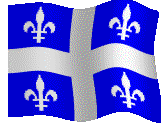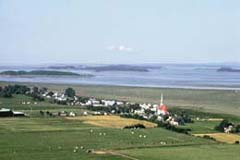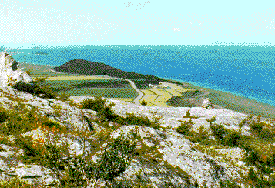![]()
|
![]()
|
The St. Lawrence River valley was the gateway to New France. It was the main transportation and communications route with the home country, and the fertile center of the new colonies. The best lands of the major settlement, at Quebec city, were quickly occupied, and the Seignieurs responsible for the lands to the east on both sides of the river worked hard to fulfill the terms of their land grants (otherwise they would lose their grants). So, they constantly sought out settlers to occupy, clear, and farm concessions of land in their own grants. Clearing the heavily wooded land was hard work, however, and cleared land was not given up easily. So why would a farmer give up his land to clear a plot elsewhere? The enticement was simple -- more (and more fertile, hopefully) land elsewhere for raising their families. The Michauds had the same needs as other early settlers, so in 1671, Pierre Michaud and his new wife, Marie, left Île d'Orléans for the greener pastures of Ile-aux-Oies (Isle of the Geese). Here, their first child, Pierre, was born on February 11, 1672, and baptised by Father Morel on March 8. His godmother was Anne Macart, wife of the Sieur de Granville, a resident of the island. Moreover, on September 9, 1673, 'Pierre Michel living on the ile aux Oyes,' sold his five arpents of cleared land on Île d'Orléans to Jean Mourier. Pierre probably worked in the service of Sieur de Granville for three years; then he exercised his right to move over to the neighboring Ile-aux-Grues (Isle of the Cranes), just opposite Cape-St-Ignace on the St. Lawrence River.
Ile-aux-Grues is the only one of the 21 islands and small islands of the Ile-aux-Grues archipelago to be permanently inhabited. Today, although only five kilometers in total size, the island is home to nearly 250 permanent residents. On April 28, 1675, Pierre acted as godfather to Marie-Anne Soucy, born on Ile-aux-Grues. By the winter of 1681, the Michaud family, now including five children, was still living on their island farm, with six arpents of land under cultivation, 10 animals and a hunting rifle. Pierre's family was growing however, so, at the age of 44, he and his family crossed to the south shore of the St. Laurence River, to a place called l'Islet. He would work his new lands here for 11 years, and have his last five children here. In 1692, Dame Genevieve Couillard, widow of the late Sieur du Tarte, enticed Pierre to move to her fief at Saint-Jean-Port-Joli. A concession, privately granted, was made on October 19, 1695, by the Seigneuresse, but two years later this land was resold by the Michauds to Pierre Lessard, because they had found an even better piece of land. The records show that by June 30, 1695, Pierre and Marie held official title to a concession of 12 arpents of prime frontal property on the St. Lawrence River, at Kamouraska. By then, they may have already lived on this land for a few years, and they would not be alone there: the Ancelin family had also moved to the growing town of Kamouraska as well.
On October 18, 1704, Marie Ancelin, with her children in mind, convinced the Seigneur Louis Aubert de Forillon to add 8 arpents of width to the 12 existing arpents of cleared land the family possessed. She would live another twenty years on this property. On April 20, 1724, the family made an inventory of her possessions. Nine days later, Marie gave her assets to her son, Joseph, and placed herself in his care. Five years later, in 1729, she died. She was buried at Kamouraska on April 18, 1729. Pierre and Marie's nine children had, within four generations, produced 458 Michaud heirs in the New World. Their second son, Jean Baptiste, continued the family line as follows....
| ||||||||||||
|
|

![]()
HOME
|
Writing Resource Page
|
Genealogy Page
|
INDEX

